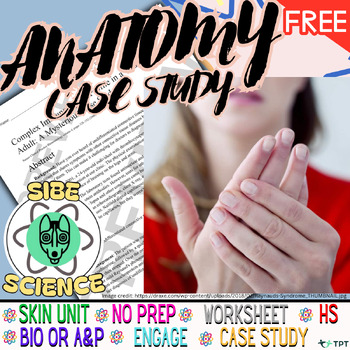Integumentary System, Anatomy And Physiology, Case Study, Raynaud syndrome, FREE
- PDF
- Internet Activities
- Webquests
Description
✋️This FREE resource is for Anatomy and Physiology. Enhance your histology or integumentary system unit with engaging content designed to captivate students' curiosity and deepen their understanding. This FREE case study explores the wonders of cellular science, Raynaud's syndrome, alternatively referred to as Raynaud's phenomenon, is a health condition characterized by the constriction of small arteries, leading to episodes of decreased blood flow to the extremities' arterioles. Download this FREE case study now to spark curiosity and transform your classroom experience with our complimentary resource: "Anatomy Case Study: A Mysterious Immunological Profile!"Download now to spark curiosity and transform your classroom experience!✨
✅FREE Resources included: Digital resource format type: PDF
If you are interested in this product, check out Case Study: Jane Doe's Journey with Ehlers-Danlos Syndrome Which is another free resource, so you can build your histology or integumentary system units with more engaging lessons!
✅Why Choose This Product for Histology or Integumentary System Units:
- Histological Exploration: Delve into the microscopic world of tissue pathology and immune system response.
- Integumentary Insights: Uncover the intricate connections between autoimmune disorders and the skin.
- Clinical Relevance: Bridge the gap between textbook knowledge and real-life diagnostic challenges.
✅Are you struggling to find content for Histology or the Integumentary System units? This product is tailored for you!
Benefits for Educators:
- Ready-Made Lesson: Streamline your lesson planning with a structured resource adaptable to various teaching styles.
- Comprehensive Answer Key: Ensure accurate understanding with detailed responses to analysis questions.
- Free Resource: Access a valuable educational tool at no cost.
⭐Hey teacher, you matter!
Your support is incredibly valuable to us! Here's a step-by-step guide on how you can earn TpT credits for greater rewards on your upcoming purchases:
1. Visit Your Purchase History:
- Log in to your TpT account and navigate to your Purchase History.
2. Discover the "Share Your Thoughts" Button:
- Next to each purchase, find the "Share Your Thoughts" button.
3. Express Your Feedback:
- Click on "Share Your Thoughts."
- Quickly rate the product and share a brief comment.
4. Accumulate TpT Credits:
- For every feedback you provide, TpT rewards you with credits.
- Collect and redeem these credits to enjoy discounts on your future purchases.
We appreciate your insights, as they guide us in creating valuable resources for your classroom. Thank you for being an integral part of our community!
Stay in the Loop for Exclusive Offers:
- Be the first to know about our latest discounts, freebies, and product launches.
- Spot the unique icon next to our store logo and click to become a follower.
- Enjoy receiving email updates about exciting developments in our store.
Related Resources:
❄Join the Sibe Science Community: For updates about sales, and new products, and to become part of our vibrant and growing science community, please feel free to follow my store: My TpT Store
This [product/document/resource] may include materials subject to copyright or trademark protection. Including these materials is intended to fall within the principles of fair use under copyright law. The use is for educational purposes and is not intended to infringe upon the intellectual property rights of others.
All rights are respected, ensuring this product is for personal classroom use only. Redistribution or posting on websites or educational blogs, in part or its entirety, is strictly prohibited. © 2024 by Sibe Science


